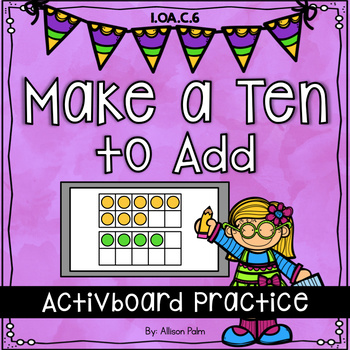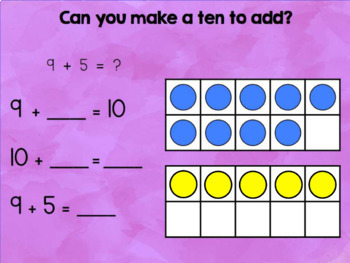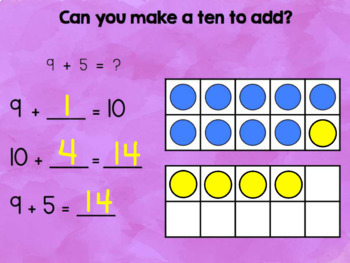Make a Ten to Add {Activboard Practice}
Allison Palm
2.2k Followers
Grade Levels
1st - 2nd
Subjects
Resource Type
Standards
CCSS1.OA.C.6
Formats Included
- Flipchart File
Pages
17 pages
Allison Palm
2.2k Followers
Description
Making a ten to add is a HUGE skill in first grade. It takes lots of practice in many different forms for kiddos to achieve mastery. Add a new element to their practice by letting them manipulate counters on the Activboard. This flipchart includes 15 slides of practice with making a ten to add using a ten frame. Students can move the counters to fill the top ten frame and then write to complete the number sentences.
This product works as a great supplement to Unit 3, Lesson 14 in the Ready Math program by Curriculum Associates.
******PLEASE READ******
NOTE: This file is a flipchart designed to be used with ActivInspire. If you do not have this software (or a Promethean Activboard), you will not be able to use the product. You can download ActivInspire here: https://support.prometheanworld.com/download/activinspire.html
Click here if you need math centers or printables to practice making a ten to add!
***********************************************************************************************
Want more Activboard practice? Check out this Activboard practice for adding with regrouping!
This product works as a great supplement to Unit 3, Lesson 14 in the Ready Math program by Curriculum Associates.
******PLEASE READ******
NOTE: This file is a flipchart designed to be used with ActivInspire. If you do not have this software (or a Promethean Activboard), you will not be able to use the product. You can download ActivInspire here: https://support.prometheanworld.com/download/activinspire.html
Click here if you need math centers or printables to practice making a ten to add!
***********************************************************************************************
Want more Activboard practice? Check out this Activboard practice for adding with regrouping!
Total Pages
17 pages
Answer Key
N/A
Teaching Duration
N/A
Report this resource to TPT
Reported resources will be reviewed by our team. Report this resource to let us know if this resource violates TPT’s content guidelines.
Standards
to see state-specific standards (only available in the US).
CCSS1.OA.C.6
Add and subtract within 20, demonstrating fluency for addition and subtraction within 10. Use strategies such as counting on; making ten (e.g., 8 + 6 = 8 + 2 + 4 = 10 + 4 = 14); decomposing a number leading to a ten (e.g., 13 - 4 = 13 - 3 - 1 = 10 - 1 = 9); using the relationship between addition and subtraction (e.g., knowing that 8 + 4 = 12, one knows 12 - 8 = 4); and creating equivalent but easier or known sums (e.g., adding 6 + 7 by creating the known equivalent 6 + 6 + 1 = 12 + 1 = 13).




